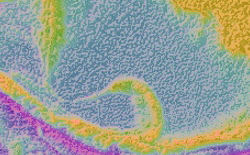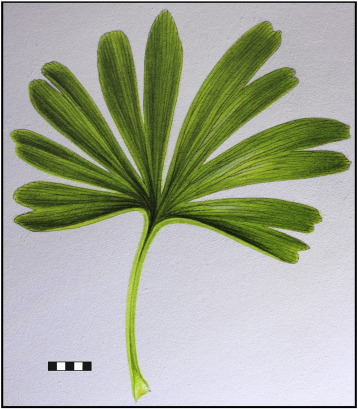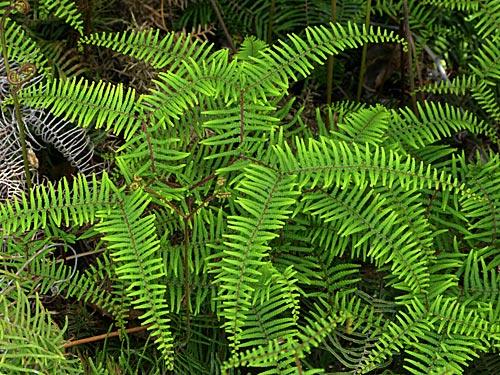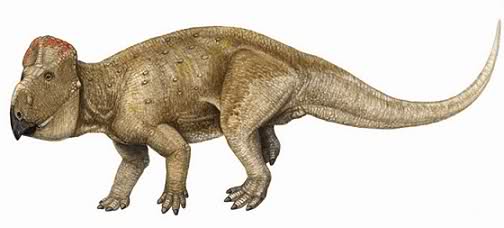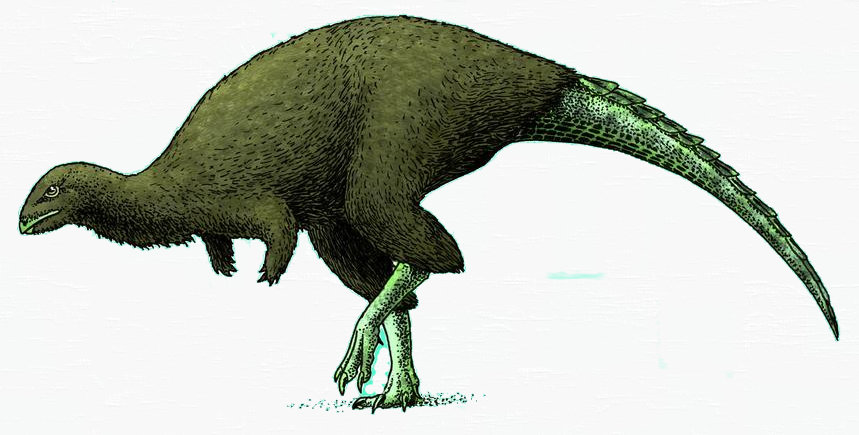 |
Alaska
Alaska apparently began as the tip of an Asian peninsula. Asia's move north swung the peninsula like a whip, pulling out Korea. Japan and Kamchatka were flung off, trailing trenches. As Alaska spun away from Asia, it laid down a trench with a small eddy from the turbulence. North America was near the end of its run when Alaska hit and merged with it, raising mountains throughout Alaska.
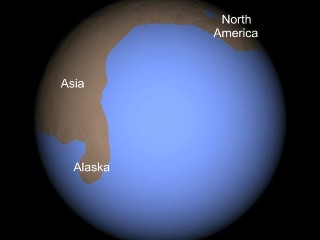
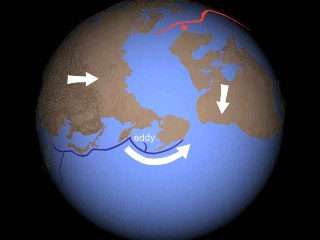
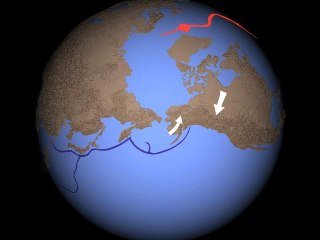
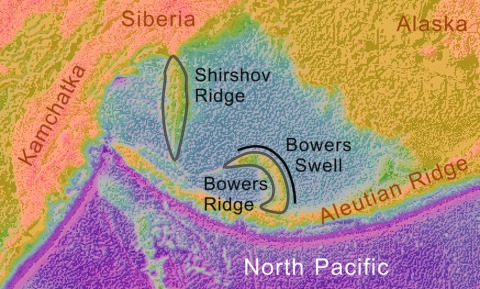
The ideas for the formation of the features of the Bering Sea are quite different in Plate Tectonics versus Shock Dynamics. The Bering Sea is bounded by Kamchatka, Siberia, Alaska, and the 3000 km-long Aleutian Ridge. It contains two curious ridges; the Shirshov Ridge and Bowers Ridge. The Shirshov Ridge extends south from Siberia, is linear, 700 km long, up to 130 km wide, and narrows at the southern end. The west slope is steep, mostly 25 - 30 degrees but up to 40 degrees, while the east slope is gentle (7 - 10 degrees).1 The "structure of the Shirshov Ridge most probably is a chaotic piling up of tectonic slabs of the crust of an ancient oceanic basin."3 The facts "indicate intense tectonization of the basement bedrock in the Shirshov Ridge, common in structures developed by considerable horizontal compression."3,1 Yet it was also once part of the edge (margin) of a continent, and was "torn away"4 from the continent. Bowers Ridge is an uplifted arc 700 km long. It is considered a volcanic ridge, although there is no current volcanism, there are no earthquakes (aseismic), and there is no evidence of subduction (remnant slab and trench).2 Along the north and east side is some slightly deformed sediment, then a mild dip (Bowers Trough) buried in sediment, and beyond that a small (90 meters high, 12 - 20 km wide) rise, Bowers Swell.
In the Plate Tectonics view, the uncertainty over the origin of the Shirshov Ridge is reflected by its having been labeled an ancient spreading center, a microcontinent, an uplifted piece of ocean floor, and the remains of an island arc.1 Researchers seem to have settled on the notion that it was formed by compression and then rifted off of Kamchatka.4 Regarding Bowers Ridge, the thinking is that it formed either before or at the same time (about 60 million years ago) as the Aleutian Ridge. Either it was 'rafted' into the Bering Sea on a piece of another oceanic plate, or it formed in the Bering Sea. Either it was a fragment of an oceanic subduction arc or it was formed along a transform fault. In any case, elements related to its origin seem to have fallen away long ago. What has researchers perplexed is the deformed sediment at the base of Bowers Ridge, and the origin of Bowers Swell. Both indicate slight compression in the relatively recent past, although as mentioned the ridge is aseismic and lacks evidence of subduction, plus it is separated from block rotation in the Aleutian Ridge.2
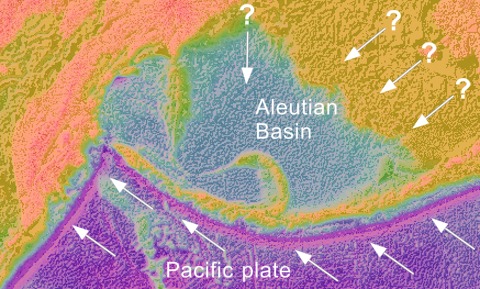
Consequently, some have surmised that the pressure may come from the motion of Siberia and Alaska pushing on the Aleutian Basin. However, "such motion is not evident in seismicity data for the Bering Sea, perhaps because the motion may be slow and limited and the seismic events may be below the threshold of detection in the world seismic network."2
As you can see, researchers have treated the Shirshov and Bowers Ridges as different and unrelated. But there is reason to think their origins are related. You may already have noticed the tiny curved line connecting the two.
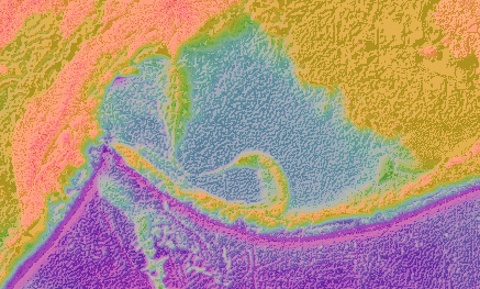
From
National Geophysical Data Center - Global Seafloor Topography from
Satellite Altimetry (updated Nov. 1997) by Walter H.F. Smith and
David T. Sandwell
The Shock Dynamics account begins with the counterclockwise rotation of Asia.
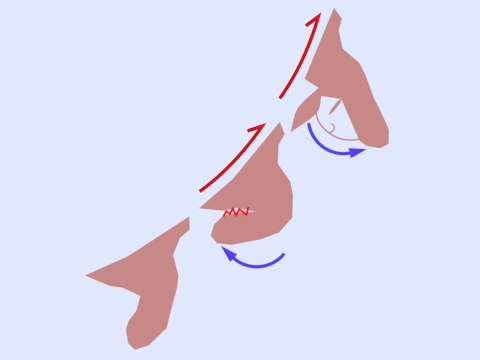
Alaska began as the end of the Siberian peninsula. As Asia started north, inertia held back Alaska and it rammed Kamchatka. This pinched oceanic crust between Alaska and Kamchatka, providing the compression found in the Shirshov Ridge. As Asia continued north, the peninsula swung outward, tearing away the Shirshov Ridge and laying down the arc of the Aleutian Ridge. Eventually Alaska separated from the peninsula and collided with North America.
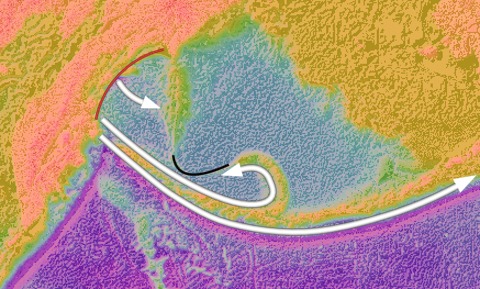
The connecting line (in black above) between the Shirshov and Bowers Ridges shows what happened. A piece of the southern tip of Shirshov Ridge was pulled off and dragged along with the Aleutian Ridge. The fluidized oceanic crust in the basin opening behind Alaska resisted the motion of the piece, and a turbulent backflowing eddy resulted. Thus light compression is on the out-thrown (east and north) side of the eddy, Bowers Ridge. That this turbulent feature 'froze' in place is consistent with the apparent Bingham fluid (temporarily fluidizes under stress) nature of the crust. Decide for yourself whether the Plate Tectonics or Shock Dynamics scenarios for the Bering Sea provide the clearest explanation.
1. Baranov, B.V., I.A. Basov, P.A. Gladkikh, A.A. Zabolotnikov, V.P. Zinkevich, M.K. Ivanov, V.V. Kepezhinskas, G.B. Rudnik, N.V. Tsukanov, O.A. Shmidt. 1984. The Bedrock of the Shirshov Ridge (Bering Sea). Oceanology, Vol. 24, No. 6, pp. 703-706.
2. Marlow, Michael S., Alan K. Cooper, Shawn V. Dadisman, Eric L. Geist, Paul R. Carlson. 1990. Bowers Swell: Evidence for a zone of compressive deformation concentric with Bowers Ridge, Bering Sea. Marine and Petroleum Geology, Vol. 7, November, pp. 398-408.
3. Neprochnov, Yu.P., V.V. Sedov, L.R. Merklin, V.P. Zinkevich, O.V. Levchenko, B.V. Baranov, G.B. Rudnik. 1985. Tectonics of the Shirshov Ridge, Bering Sea. Geotectonics, Vol. 19, No. 3, pp. 194-206.
4. Shipilov, E.V., A.Yu. Yunov, Yu.I. Svistunov. 1990. Marine Geology - A Model of the Structure and Formation of Aseismic Elevations on the Ocean Floors. Oceanology, Vol. 30, No. 2, pp. 193-196.
This simple demonstration illustrates the turbulence. A drop of colored cream is placed at the joint of two wooden paddles in a shallow pan of water. The vertical paddle represents the Shirshov Ridge.
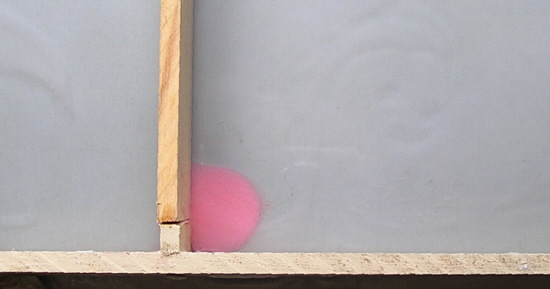
Pulling the horizontal paddle to the right represents fluidized crust drawn behind Alaska.

Larger scale flow is shown in this computer model of the escape of water under a newly opened sluice gate:

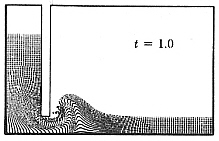

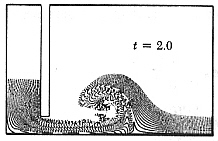
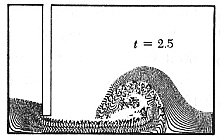
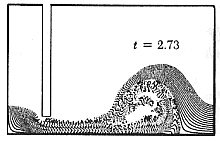
From:
Harlow, Francis H., John P. Shannon, J. Eddie Welch. 3 September
1965. Liquid Waves by Computer.
Science, Vol. 149, No. 3688,
pp. 1092-1093
|
|
|
As with all accoustically fluidized crustal features in the Shock Dynamics model, once the fluidizing energy falls below a threshold level, the crust "freezes" in place. |
The fact that both Bowers Ridge and New Hebrides-Hunter Ridge (in presentation 13, next page) can be simulated with fluid turbulence is powerful support for the Shock Dynamics model, especially when compared to the flimsy Plate Tectonics explanations.
If there is any doubt that Alaska slammed into North America along the path of the Aleutian Ridge, take a look at this topographic map.
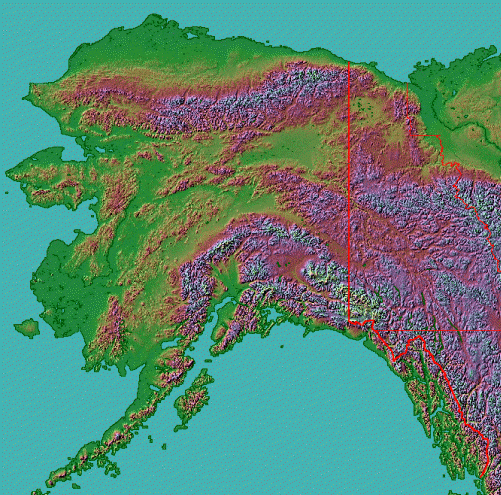
The
whole southern half is arched upward. The seismic map below
gives us an idea of where the suture line is between Alaska and
North America. It follows the extended curve of the Aleutian
Ridge. Shallow seismic waves under central Alaska show that
the lithosphere is stretched along this curve (along-strike
anisotropy)1,
as we would expect if Alaska swung east into North America.
1.
Christensen, Douglas H., Geoffrey A. Abers. 2010. Seismic anisotropy
under central Alaska from SKS splitting observations. Journal of
Geophysical Research, Vol. 115, B04315, pp. 1-12.
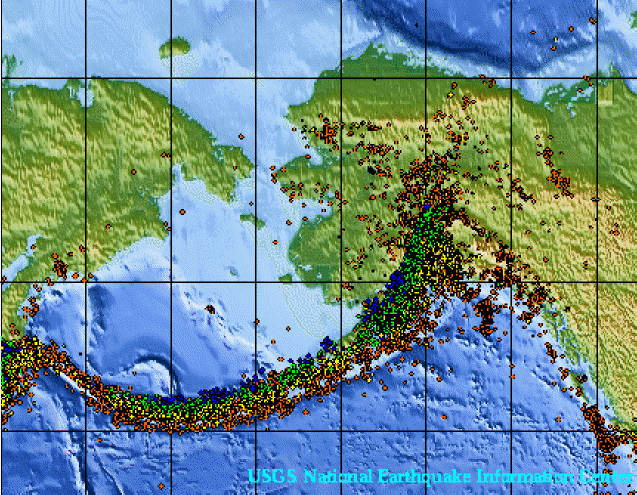
Seismicity
of Alaska: 1975 - 1995
The polar dinosaur test
"Most of the dinosaurs we have found lived along ancient rivers or streams and roamed across the adjacent forested floodplains and densely vegetated swamps and lakes. Some discoveries have also shown that dinosaurs inhabited ancient deserts strewn with fields of sand dunes. Dinosaur skeletons have also been found along the sandy shorelines of ancient seas." - Mark Norell, curator of the Division of Paleontology at the American Museum of Natural History https://www.amnh.org/explore/videos/dinosaurs-and-fossils/in-what-kind-of-environment-did-dinosaurs-live
One of the big claims of Plate Tectonics theory that made it world famous is that it explains the breakup of Pangaea. However, Plate Tectonics places many types of dinosaurs in the dark deep freeze near the North and South Poles for millions of years. Each year for months on end there would have been little or no light for plants to grow or for dinosaurs to find food or hunt, not to mention the severe cold. They could not possibly have survived. If Plate Tectonics theory is wrong about where Alaska and Australia were, the theory fails and it should be fundamentally revised or discarded. See how the Shock Dynamics geology theory compares. Here is evidence, from people committed to Plate Tectonics theory:
North Pole
From the article:
Baby
dinosaurs hatched in the Arctic 70 million years ago
by
Laura Geggel, Live Science editor, June 24, 2021 https://www.livescience.com/alaska-baby-dinosaur-nursery.html
"Baby dinosaurs toddled around the chilly region that is now the Alaskan Arctic about 70 million years ago, according to the 'unexpected' discovery of more than 100 baby dinosaur bones and teeth there, a new study reports."
"It was surprising to find evidence of a prehistoric nursery in such a cold place, the researchers said. Even during the warm Cretaceous period (145 million to 66 million years ago), Alaska had an average monthly temperature of about 43 degrees Fahrenheit (6 degrees Celsius), and for about four months of the year, the dinosaurs would have lived in permanent darkness and dealt with snowy weather, they said."
"The Prince Creek Formation of northern Alaska, where the fossils were found, is 'the farthest north that dinosaurs ever lived,' study co-lead researcher Gregory Erickson, a paleobiologist at Florida State University, told Live Science. 'I don't think it was possible for them to live any farther north,' as what is now Alaska was shifted closer to the North Pole than it is today. It's right up there with Santa Claus."
Late
Cretaceous North America
MAT - mean annual temperature
CMMT
- cold month mean temperature
"After analyzing the babies' teeth and bones, the research team determined that the remains belonged to seven different dinosaur species. The discovery indicates that dinosaurs likely lived in this frigid region all year, as the babies would have been too small for annual migrations shortly after hatching, Erickson said."
"'How they pulled it off, we don't know,' Erickson said. Some small dinosaurs might have burrowed and hibernated, but larger dinosaurs - such as duck-billed dinosaurs and tyrannosaurs - weren't able to burrow."
"Based on knowledge of dinosaur life cycles, the researchers concluded that these baby dinosaurs stayed put after hatching, as they wouldn't have had time to mature before winter set in."
"These long egg-hatching times, 'combined with the fact that you had a very short growing season up there to flourish before the winter set in, [baby dinosaurs] just did not have time' to grow big enough before migrating southward, Erickson said. 'There's no way that these tiny dinosaurs made the march down to Alberta to escape the winter.'"
"There is evidence that some long-necked sauropod dinosaurs and duck-billed dinosaurs at lower latitudes of western North America migrated, but it's likely that the Alaskan dinosaurs, especially the smaller individuals, stayed put, the researchers said."
The research was published in: Druckenmiller, Erickson, Brinkman, Brown, Eberle. 2021. Current Biology, Vol. 31, pp. 1–10. DOI:10.1016/j.cub.2021.05.041
Dinosaur families found in the Prince Creek Formation include Hadrosauridae, Thescelosauridae, Leptoceratopsidae, Ceratopsidae, Tyrannosauridae, Dromaeosauridae, Troodontidae, and Avialae.
CO2 levels are thought to affect average temperatures worldwide; the higher the hotter. Past global CO2 levels in the atmosphere have been estimated by many researchers in different ways. Below is a chart combining estimates from various studies published up to 2012. At 70 million years ago, most estimates range from 500 to 1100 parts per million (ppm). It is uncertain how much effect the CO2 level would have had on polar temperatures. The level today is about 420 ppm.
North Slope dinosaurs
In a PBS NOVA television program "Arctic Dinosaurs", that aired October 7, 2008, the producers brought together specialists in several fields to investigate dinosaur fossils on the north coast of Alaska (the Liscomb bone bed by the Colville River on the North Slope). They uncovered a variety of dinosaur fossils.
Today, the Liscomb bone bed is on a latitude of about 70°N, 1,500 miles from the North Pole. Temperatures there can drop to minus 60°F. According to Plate Tectonics, 70 million years ago it was even closer to the North Pole, only 350 miles from it at nearly 85°N, where there is total darkness for 120 days each year.
Footprints from a herd of Hadrosaur dinosaurs found in the Upper Cretaceous Cantwell Formation in the Alaska Range, Denali National Park, Alaska, preclude the possibility that they migrated far away for the winter. It is the largest tracksite known this far north. According to the researchers, "Caribou migration distances are often mentioned as possible analogs for distances that hadrosaurids might have been capable of achieving as they traveled from high latitudes to the temperate latitudes for warmer climes."3 Yet even "these hypothesized migration distances are inadequate to have taken the hadrosaurids out of the northern polar region."3 "These animals, however, did not migrate significant distances to lower latitudes during the winter, based on 1) a bio-mechanical argument from hadrosaurid bones found in northern Alaska2... and 2) evidence from this new tracksite for very young juvenile hadrosaurids in the herd that would have been incapable of making such a long journey."3 They "therefore lived in high latitudes year round".3
A member of the team, British paleobotanist Robert Spicer, had been studying the many types of plant fossils found in this area since 19761. He used a global statistical model to determine very precisely the average temperature of this area when the dinosaurs lived there, which the researchers assumed was 70 million years ago.
Spicer concluded that when the plants lived there the average temperature was about 42°F, which is 30 degrees warmer than it is today. Paleoichnologist Stephen T. Hasiotis studies fossil tracks of birds, insects, and worms. He described the ancient scene this way: "Picture yourself standing on this lake shoreline. It's warm and sunny; there are herds of duck-billed dinosaurs and other kinds of plant-eating dinosaurs along the lake, eating vegetation like horsetails, gingkoes, the flowering plants; an abundance of flying insects and crawling insects are on the shoreline, in the water; Theropod dinosaurs... are hunting these plant-eating dinosaurs."4 Hans-Dieter Sues of the Smithsonian Institution added, in "the good times of the year, when it was not dark and cool, it probably would have been very similar to what we now see in the southeastern United States, with lots of conifers, lots of flowering plants. In fact, the Late Cretaceous, except for the dinosaurs, would not have been an unfamiliar environment to us."4
This fits the Shock Dynamics model exactly, which says that Alaska began far to the south, about the latitude of Maryland, USA, before it was flung north by the impact event (see the pictures and video at the top of this page).
However, Plate Tectonics theory obviously has a real problem with dinosaurs at the North Pole, for millions of years.
The researchers found evidence that the size of the top arctic predator species, Nanuqsaurus, was about 30 feet long and 6 feet high at the hip, not a pygmy dinosaur as previously thought. As mentioned, it was shown covered with feathers, even though there is no fossil evidence that it had feathers. It would require large herds of prey to feed meat-eaters that big, and apparently they were there.
A huge footprint from a Nanuqsaurus was found in south-central Alaska's Denali National Park along with footprints from many other dinosaur species. The kicker is that the footprints are on what is now a steep slope! An article in 2023 reported "the largest tracksite known in Denali National Park and Preserve and all of Alaska - a 7500 square-meter outcrop of steeply dipping beds known as the Coliseum. The site exposes 66.3 meters of vertical [depth] section consisting of laterally extensive fine- to medium-grained sandstone, mudstone, calcareous shale, and bentonite."10
The picture shows one section of the slopes. Each little spot is a dinosaur track made in mud when the ground lay flat.
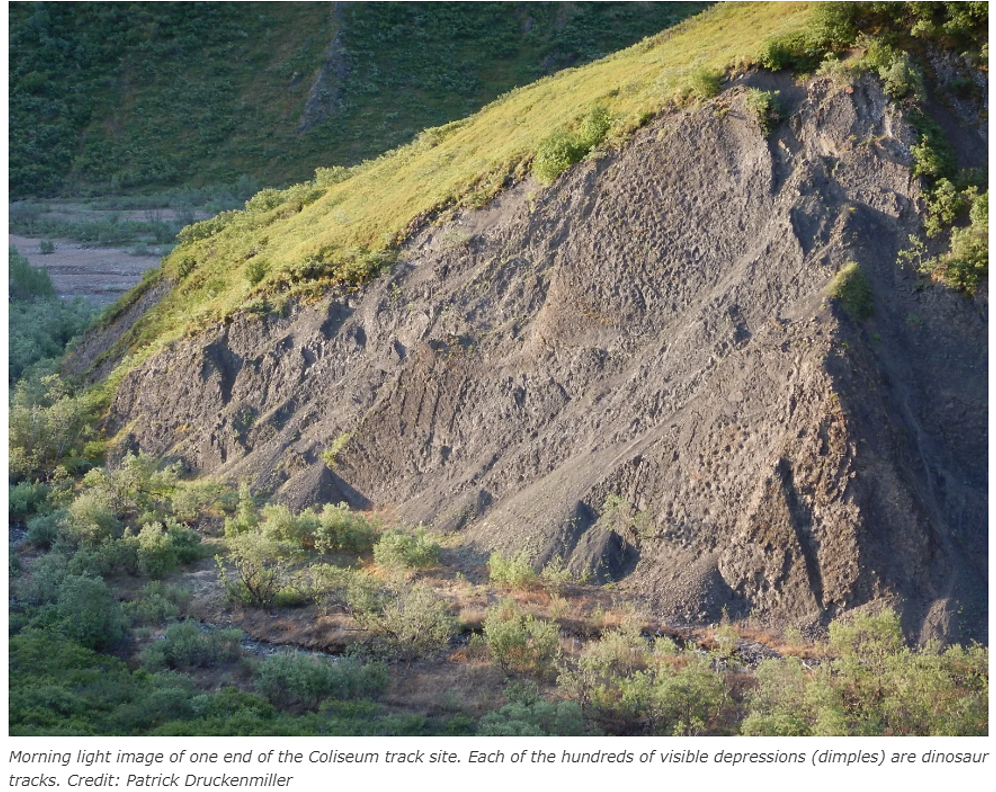
The footprints were made by "ornithopods, ceratopsids, and large and small-bodied avian and non-avian theropods." "U-Pb dating of bentonite collected from the site returned an age of 69.3 ± 0.9 Ma."10 Denali National Park and Preserve is outlined in green below.
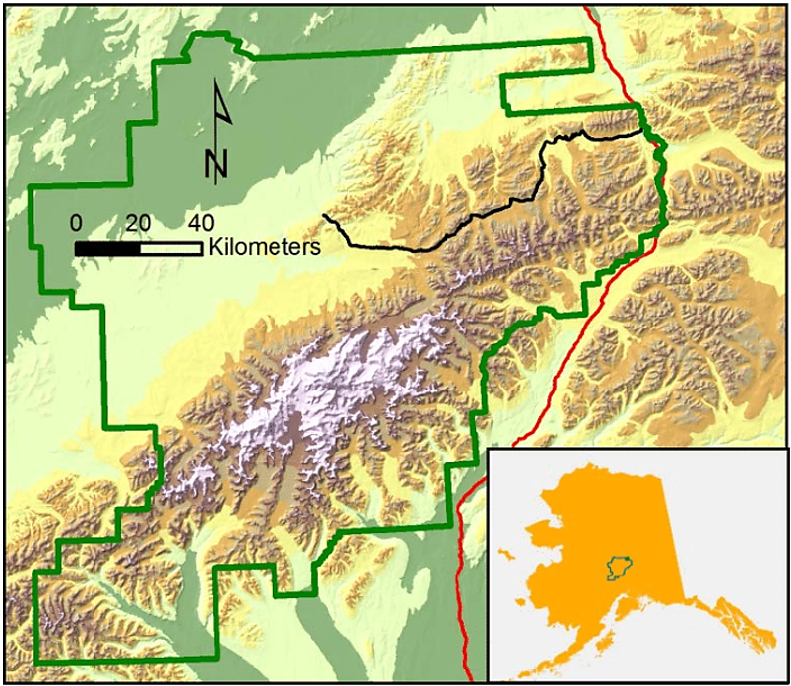
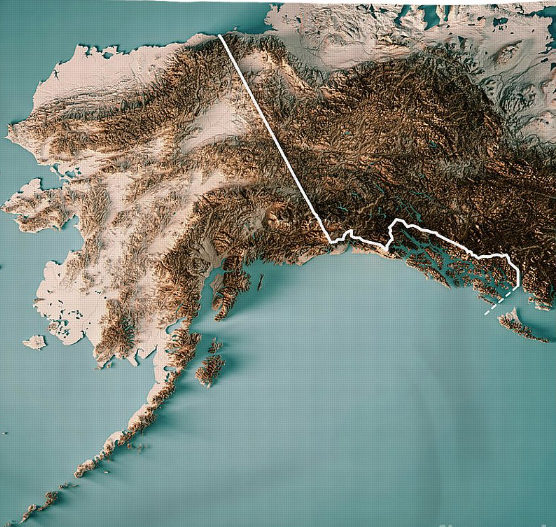
Thus the Alaska Range of mountains were raised after the dinosaurs had walked on the flat, marshy ground, just as the Shock Dynamics geology theory proposed. Despite the dramatic music and confident narration, the documentary failed to solve the polar problem because it is impossible. Dinosaurs could not have lived where Plate Tectonics and the Geological Timeline place them, which disproves them both. Only Shock Dynamics fits the facts.
South Pole
Just 560 miles from the South Pole in West Antarctica, "a temperate lowland rainforest environment existed at a paleolatitude of about 82 degrees South during the Turonian-Santonian age (92 to 83 million years ago)."9
A 2020 report said that "about 90 million years ago, West Antarctica was home to a thriving temperate rainforest, according to fossil roots, pollen and spores recently discovered there. Study co-researcher Ulrich Salzmann, a paleoecologist at Northumbria University in England, said 'The numerous plant remains indicate that the coast of West Antarctica was, back then, a dense temperate, swampy forest, similar to the forests found in New Zealand today'."8
"Sea levels were 558 feet higher than they are today. The sediment core revealed that during the mid-Cretaceous, West Antarctica had a mild climate, with an annual mean air temperature of about 54 F, similar to that of Seattle. Summer temperatures were warmer, with an average of 66 F. In rivers and swamps, the water would have reached up to 68 F."8
"These temperatures are impressively warm, given that Antarctica had a four-month polar night, meaning that a third of every year had no life-giving sunlight."8
Fossil plants in Cretaceous rocks in southeastern Australia and New Zealand are of ferns, trees, and mosses in a swampy environment.
Here are a few examples
|
|
|
|
|
|
|
|
|
|
|
|
They were abundant enough to feed plant-eating dinosaurs such as
|
|
|
|
|
and there were enough of those to feed carnivorous dinosaurs such as
|
|
|
There are fossils of these dinosaurs, as well as fossil mayflies, water beetles, wasps, ants, fleas, flies, spiders, earthworms, and horseshoe crabs.
Where was southeastern Australia when these early Cretaceous fossils were buried?
Plate Tectonics theory says it was near the South Pole, at about 75° South
The fossils were
found near the red dots on the map
From: http://home.alphalink.com.au/~dannj/ecenvir.htm
where for 50 days straight every year it is totally dark.
Plate Tectonics places southeastern Australia there for not just 10 years, or 100 years, or 1000 years, but for 40 million years – between about 140 and 100 million years ago. The Early Cretaceous fossils are assigned dates from 115 to 105 million years ago, but the plants, animals, insects, and environment must have been well-established before that.
This is how 75° South looks now, at high noon on New Year's Day.
The situation has puzzled paleontologists for many years, and they have offered several ideas within the Plate Tectonics framework:
1) Did higher levels of CO2 in the atmosphere produce a global greenhouse that warmed the South Pole?
This is the same global CO2 chart shown above for the North Pole discussion. The hottest projections are from about 78 to 95 million years ago. Between 105 and 115 million years ago, the estimates range from 400 to 3200, with most in the range of 500 to about 1700. Again, it is hard to tell whether the CO2 level would have had much effect on polar temperatures. The level today is about 420 ppm.
2) Did the dinosaurs migrate to higher latitudes before winter?
"…dinosaurs living at the poles would have to pass through 30° of latitude, about 2000 miles or 3200 km, in order to avoid the total darkness of a polar winter; in other words, a seasonal migration of 6400 km. No terrestrial animal achieves such distances today."5 Large portions of Australia were also covered by water.
While big dinosaurs such as Abelisauridae with long strides could conceivably make long seasonal migrations, at enormous energy costs, smaller polar dinosaurs, including ankylosaurs and hypsilophodontids, appear unable (based on biomechanics or absolute size) to migrate long distances.5 For example, "the odd gait… limited range of motion and stocky leg design contribute to the inefficient mechanics of the leg"5 of ankylosaurs.
3) Did the dinosaurs evolve large eyes to see during the long, dark days of winter?
"Hysilophodonts are a group of small ornithischians that, while rare in the Northern Hemisphere, tend to dominate Austral [South] polar communities."5
"The enlarged optic lobes and expanded [eye] orbits found in the Australian hypsilophodont, Leallynosaura amicagraphica, suggest this animal had acute vision compared with its northern, low-latitude counterparts."5 Some researchers "argued this to be a possible adaptation to counter the long, dark polar winters."5
However, "small species and juveniles of larger taxa typically possess enlarged orbits and big brains in comparison with other cranial features… Possession of these characters, therefore, does not necessarily mean vision was exceptional."5
4) Did the dinosaurs hibernate to survive the cold, dark winters?
"During the Early Cretaceous, the state of Victoria, Australia, lay within the Antarctic Circle between the paleolatitudes of 75°S and 80°S."6
"The microstructures and cyclical growth exhibited by both ornithopods [hypsilophodontids] and theropods [Abelisauridae, Timimus] from the high paleolatitude of southeastern Australia resemble patterns observed in dinosaurs from lower paleolatitudes, indicating similarities in growth dynamics and physiology. Although LAGs [Lines of Arrested Growth] can form as a result of the slowed metabolic processes experienced during hibernation, they are not microstructural features exclusive to hibernators."6
"…we suggest that the presence of growth marks [LAGs] alone cannot be used to support a hibernating behavior."6
And "no evident physiological modifications appear to be linked with the distribution of ankylosaurs and other non-avian dinosaurs at higher latitudes (>60°S)."7
So in Plate Tectonics theory, plants, plant-eating and meat-eating dinosaurs were on an isolated continent consisting of Antarctica, Australia, New Zealand, and the Chatham Islands all merged together near the South Pole, where it was dark a third of each year, for 10 to 40 million years. Yet there is no evidence for dinosaur hibernation, migration, or special adaptation to South Pole winters.
Contrast that with Shock Dynamics, where southeast Australia began next to Africa at 23°S and moved to where it is today without going near the South Pole. Similarly, West Antarctica was attached to Africa, and was pulled away with South America.
It is clear that the dinosaurs and plants found at these places could not possibly survive for 1 year, and certainly not millions of years, where Plate Tectonics theory requires them to be, so it fails the Polar Dinosaur test. Shock Dynamics geology theory, on the other hand, fits the evidence nicely.
* * * * * * * *
1. Brouwers, E.M., W.A. Clemens, R.A. Spicer. 12 May 1987. Dinosaurs on the north Slope, Alaska: high latitude, latest Cretaceous environments. Science, Vol. 237, pp. 1608-1610.
2. Fiorillo, A. R., R. A. Gangloff. 2001. The caribou migration model for Arctic hadrosaurs (Ornithischia: Dinosauria): A reassessment. Historical Biology, Vol. 15, pp. 323-334. Doi: 10.1080/0891296021000037327
3. Fiorillo, Anthony R., Stephen T. Hasiotis, Yoshitsugu Kobayashi. Published online 30 June 2014. Herd structure in Late Cretaceous polar dinosaurs: A remarkable new dinosaur tracksite, Denali National Park, Alaska, USA. Geology. Doi: 10.1130/G35740.1
4. Transcript of "Arctic Dinosaurs". October 7, 2008. NOVA on PBS. Online address: http://www.pbs.org/wgbh/nova/nature/arctic-dinosaurs.html
5. Bell, Phil R., Eric Snively. 2008. Polar dinosaurs on parade: a review of dinosaur migration. Alcheringa: An Australasian Journal of Palaeontology, Vol. 32, No. 3, pp. 271-284 DOI: 10.1080/03115510802096101
6. Woodward, Holly N., Thomas H. Rich, Anusuya Chinsamy, Patricia Vickers-Rich. 2011. Growth Dynamics of Australia’s Polar Dinosaurs. PLoS ONE, Vol 6, No. 8 e23339 DOI:10.1371/journal.pone.0023339
7. Cerda, Ignacio A., Zulma Gasparini, Rodolfo A. Coria, Leonardo Salgado, Marcelo Reguero, Denis Ponce, Romina Gonzalez, J. Marcos Jannello, Juan Moly. 2019. Paleobiological inferences for the Antarctic dinosaur Antarctopelta oliveroi (Ornithischia: Ankylosauria) based on bone histology of the holotype. Cretaceous Research, Vol. 103, 104171 16 pages, DOI: 10.1016/j.cretres.2019.07.001
8. Geggel, Laura - Associate Editor of Live Science. April 02, 2020. Remains of 90 million-year-old rainforest discovered under Antarctic ice. LiveScience. https://www.livescience.com/ancient-rainforest-antarctica.html
9. Klages, Johann P. et al. 1 April 2020. Temperate rainforests near the South Pole during peak Cretaceous warmth. Nature, Vol 580, No. 7801, pp. 81-86 DOI:10.1038/s41586-020-2148-5
10. Stewart, Dustin G., Patrick S. Druckenmiller, Gregory M. Erickson, Jeff A. Benowitz, Denny M. Capps, Cassandra L. Knight, Kevin C. May, Paul J. McCarthy. Published online 27 July 2023. Vertebrate ichnology and palaeoenvironmental associations of Alaska’s largest known dinosaur tracksite in the Cretaceous Cantwell Formation (Maastrichtian) of Denali National Park and Preserve. Historical Biology DOI:10.1080/08912963.2023.2221267
